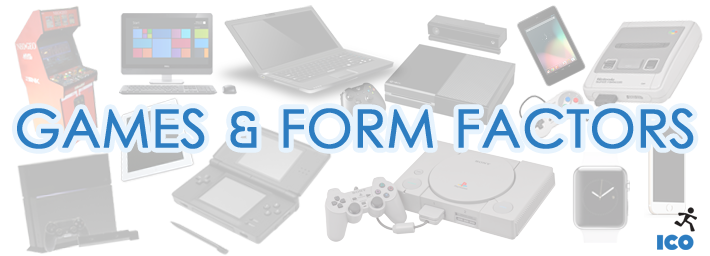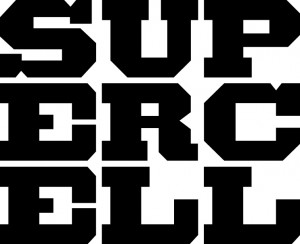In a recent article on gamesindustry.biz, Jurie Horneman mentioned a notion I have been discussing on and off when talking (mostly with students) about monetization and business models. That notion is form factor and its role in the process of building a game.
This goes beyond the way you monetize a game, but as this is the core topic I am usually addressing, they are often associated in my past lectures on the topic.
Before Jurie’s article, I had been contemplating putting down a blog post on this topic and its role in the process of building a game. With his article on play context out, I think this is as good a time as any to actually do this.
I’ll try to keep this concise, though might expand on the below some time in the future.
What is the Form Factor?
In the hardware space, the form factor is the shape of a device and what that shape is trying to convey to the users. It can be how the device will be used (one hand versus two hands) or how it will be perceived (luxurious or affordable).
The term is frequently used in the mobile sector to compare different devices – the fact that the shape of the object has a direct impact on usage makes it a core element of their design: you hold it your hand after all, and both input and display are combined.
The notion I am referring to is a bit of an abuse of the term in that sense, but it has felt like the right term when I first used it, and has grown on me since, so I hope you will allow me this xxx to me.
The form factor I am referring to is not specific to a device, but a wider notion across different type of designs. Where game making is concerned, I consider that more or less all touchscreen mobile phones share the same form factor, and the same holds true for all tablets.
But it also goes beyond the physical characteristics of the device and includes what are the input mechanisms, where you sit in the real world when you play the game. The obvious game platforms we can distinguish here are consoles (in the couch with a pad) and PCs (at a desk, with mouse and keyboards). Those would be two fundamentally form factors that would lead to different game design decisions.
But to make it complete on the notion, I need to add a third layer here as well: the software environment. That’s really needed to account for PCs, but there might be other use cases I haven’t thought of. So, in the same way the user behaviour and expectations on a game experience will vary based on the device the player is playing on, the same holds true on whether they play a game from a client on the desktop, or in a browser, or in a browser on Facebook. Playing a game in a browser puts the player in an environment prone to distraction. Many people run live social channels on that same browser – as you play that game you will more than likely see notifications taking you in and out of your game experience. The perception of the value of the game is also going to be different if it runs in a browser or as an independent client. Facebook is just that extra layer on top of the browser, making friends interactions easier, but distractions also more numerous. It dramatically change the game experience.
I am not shoe-horning an extra level – the usage pattern differences are the same and it belongs to that Form Factor notion. And I have a great example illustrating all those principles very elegantly:
Supercell
Supercell, makers of Hay Day, Clash of Clans and Boom Beach is (rightfully) seen as the epitome of the successful mobile developer. They have been valued at over $3bn and have run ads during the Superbowl, but what do they have to do with form factor and video games?
I am a big believer in understanding companies through their history and what is in their DNA. To me Supercell is the epitome of a business built around the understanding of form factors and video games.
So, let’s go back in time a bit. Diane and I met Ilkka Paananen for the first time in 2011, in the early days of Supercell. At the time, Ilkka was presenting Supercell as “the next generation’s Bigpoint”. The company strategy was to build very high production value browser based games, trying to replicate Bigpoint success story, still on the browser, but with high quality, real-time, 3d looking games.
At the time, I was very convinced with the validity of the idea. There was a lot of discussion about 3D in the browser, Unity was on the rise making this easier, and you could do a lot of things with flash (which was Supercell’s approach) that looked 3D and polished. Plus there was this feeling that browser based games were ready for real time gameplay.
Supercell’s very first game was Gunshine. Imagine a diablo-like game, real time, top down 3D, set in a post-apocalyptic world, running in flash and our browser.
Or have a look at the trailer:
The game was incredibly polished and smooth for a flash game. The production value was through the roof, the code behind was incredibly robust (never seen a flash game that complex run that smoothly), the gameplay was decent with a few genuine nuggets of brilliance here and there. And a commercial failure.
And it wasn’t a matter of a bad launch and Supercell moving on. The launch failed, then the re-launch (with much improved onboarding, and reworked gameplay) failed, and the re-branded launch (under the much easier to remember and much more explicit title Zombie Online) failed.
And they went back to the drawing board. The core concept didn’t change, but they shifted the interpretation of it. They still went to build the “next generation’s Bigpoint”, but rather than looking at what the current browser could do that the old one couldn’t, they went to what is essentially the next generation’s equivalent platform: the tablet.
Not the mobile phone, the tablet. The early days of Supercell after that pivot was very very focused on game for tablets. All their marketing and communication was focused on the fact that their games were iPad games, not mobile games.
The other thing that changed was instead to try to graduate “browser games” to “proper games”, taking a 3D real time Hack & Slash game to the browser. Supercell went to take “browser games” to the new casual ultra accessible platform. Hayday is Farmville. Clash of Clans is Travian. They are very different executions of those games (especially Clash of Clans from Travian), but they are the same core games. And the same core games properly executed for the form factor of the tablet: the real estate of the screen is really optimised for a tablet; the orientation is landscape rather than portrait.
Tablet orientation http://t.co/DN50EsJB9e pic.twitter.com/ZEyhCMcDo2
— Luke Wroblewski (@lukew) April 20, 2015
Smartphone orientation http://t.co/DN50EsJB9e pic.twitter.com/EWD76THz0Z
— Luke Wroblewski (@lukew) April 20, 2015
But those games also benefitted from that tablet-first approach from the fact that players play differently on those devices. The better battery life means longer game sessions. The perceived value of the games played on a larger screen (compared to phones) makes the payment process more acceptable.
Had Supercell used a mobile-first approach, which at the time was much more the norm, I believed they would not have had the same success.
They have now transitioned from that position, and the market has evolved as well. What was considered high production value back then is not the same; the acceptance of the Free-to-Play model has grown significantly over the years; and those aspects are part of that notion of the form factor: users expectations and perception related to the devices and platforms they use need to be part of the design process of the games.
Another anecdote to close this example section, a few years back, Diane did a mission for a company running a game in a browser. During the mission, they extended the game to mobile as well. The game was cross platform between its iOS version and its browser version. This was the exact same game, with mostly the same audience (at the time). They suddenly monetized better. From one version to another, users felt that now, the game was 1/ worthy of their investment; 2/ said investment was way easier to perform through the App Store in-app purchases. Payment integration, as part of the user experience, is part of the form factor considerations.
Concluding thoughts
I could write a lot about designing game for the form factor, there is a lot to say. I will leave you with a few thoughts on platforms beyond the mobile/PC/Consoles triptych, and how we need to integrate their form factor when designing games for them:
- Coin-op. How much of the design of those games were based on the fact that you were playing the game in a social environment; you needed short sessions, that were fulfilling but would leave you with a will to get more. How would you design a coin-op game, in 2015?
- So many things we don’t know yet on how games in VR will be played. Session length for instance? There are a lot discussion around making session short, but do we really know. Input devices? Valve and Sony have ones, but are they ideal, what do they imply when they haven’t been used them by large groups? Price points? If there is some truth in the idea that the smaller the screen, the cheaper people expect the game to be, would that mean that VR games could be accepted at a higher price point?
- Smart watches. What is a good game experience with those? Will they be relegated to notifications from your mobile games, or can they build their own genres of games?





Leave a Reply
Want to join the discussion?Feel free to contribute!